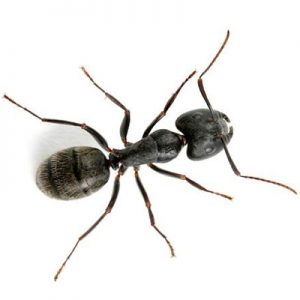As summer is upon us the chances of you seeing the presence of ants in your home increases as the temperatures go up. Carpenter ants do not use wood as their food source, they create tunnels for their homes and brood rearing. Carpenter ants prefer to tunnel through wet or moist wood in your home or deck or fence posts that can be exposed and water damaged. Once the initial home is built carpenter ants can extend the tunnels into undamaged wood potentially causing structural damage if inside the home or severely weakening posts of decks or fence lines. Carpenter ants prefer to feed on other insects, plant and vegetable matter and like other ant species will put aphids into slavery to milk them of their sweet honeydew which aphids release like a sticky sap. Inside homes if fruits become decayed they will be very attracted to that as a potential food source.
Carpenter ant colonies can bud out into new colonies but they are always able to return to the main colony as workers forage for food sources. What is amazing is the queen can live anywhere from 10-15 years in a healthy, food rich environment and produce over 50-70,000 new young over her lifetime. A carpenter ant colony won’t produce a new queen for a new colony until the currently colony has established itself for at least 3-6 years and have approximately 2,000 workers. In those colonies there is a reproductive winged new queen, reproductive winged males and 3 varying sizes of drone workers which range from 6 millimetres to 25 millimetres.
It’s important to recognize carpenter ants telltale signs of their presence in the little piles of sawdust they produce through the crewing creation of their tunnels, the ants themselves (smooth thorax, one node as basic ID characteristics), winged swarmer’s, known water damaged wood, and the actual chewing noises behind walls or in wall voids. They have a distinctive chewing noise and that will assist you in finding the nest(s). Control is key removing decaying/moisture affected wood or vegetation near the foundation, change the humidity in the home if it’s too high, keep a barrier from your house that does not include plants, or other conducive wood to prevent entrance into homes, or decks or fence posts. Determining where the primary nest or satellite nests are located.
Calling the professionals at Poulin’s will help rid your home of these structural damaging pests. Only Poulin’s will recommend the best treatments, licensed and trained pest management professionals, only using registered ant control products, protocols and solutions for your home or business that may be affected by carpenter ants.

